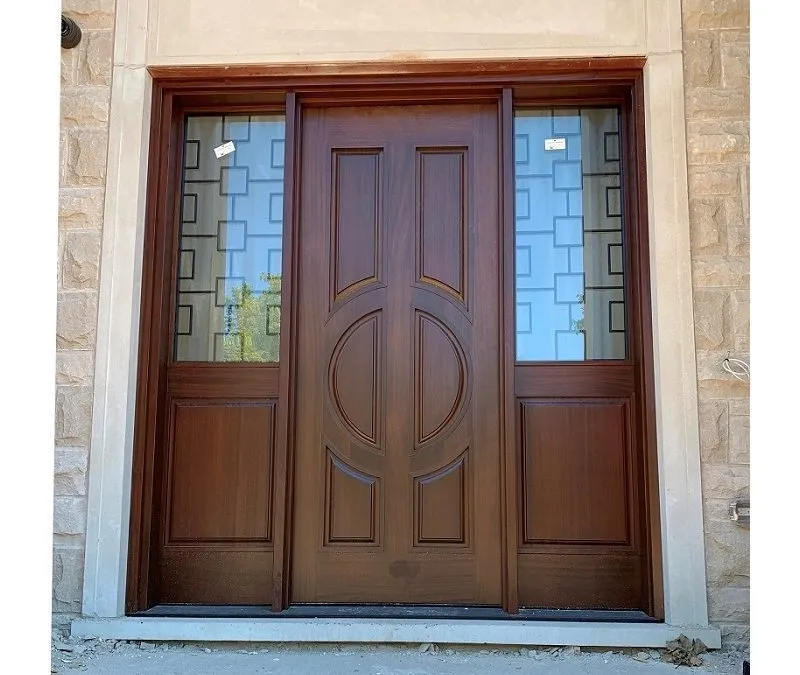If you’re one of the more than 580,000 new homeowners in Canada this year, sprucing up your home’s exterior door may be on your ‘to-do’ list. Or, if you’ve purchased one of nearly 295,000 newly constructed homes, then choosing the right front door is essential to transforming your house into a home. Maybe you’ve added a fresh coat of paint, new siding, or contemporary windows and want the style of your entry door to align with your home’s updates.
Whatever the reasons for your first step toward a custom front door, the journey is more enjoyable with a guide to milestones along the way. Read on for tips to support the decision-making process about your new front door.
Visualize Your Front Door Design
When you purchase custom doors for your home, you can incorporate your creativity and style into the design. Because the front door is a focal point, aligning it with the house style will make your entryway appealing. Questions to consider during the design phase include:
- Do you want a front door that stands out or complements the home’s exterior?
- Brighter colours are a trend that lends a ‘pop’ of personality to your home. From turquoise to rustic red or elegant navy, paints provide a wide range of options to customize your entry door.
- Natural wood tones provide another broad and versatile palette of colours that enhance your home’s exterior. Red or white oak, black walnut, or sapele are just a few of the woods available to create a warm and welcoming front door.
- How do you want visitors to experience the entrance to your home?
- If your house is a traditional style, then a stately front door can make an impressive statement.
- Contemporary architecture may lead you to choose a front door design with metal accents or glass inserts.
Your entryway should also reflect your personality. Whether bold, subtle, substantial, or light, the impression your custom door makes as visitors enter and leave your home is lasting.
So, grab a sketchbook or your camera and start capturing images of front doors that catch your eye. Online resources can inspire, too, especially if you want to get a glimpse of trends in entry doors.
Select the Exterior Door Material
When you have your front door design in mind, the next step on your journey is to choose the material. Options include fibreglass, medium-density fiberboard (MDF), steel, and wood.
- Fibreglass entry doors consist of moulded glass-fibre reinforced polymers placed on a hollow frame filled with foam insulation. Although some level of customization is possible with fibreglass, the material is tough to trim, making it less suitable for non-standard entryways. And research shows the potential resale value (or cost recovered) of a fibreglass door is about 60%.
- Engineered wood makes up the foundation of MDF exterior doors. Manufacturers combine hardwood and softwood fibres with wax and resin and form the material into panels using pressure and high temperatures. MDF is cheaper than other woods, and the smooth surfaces on most MDF door designs hold paint well. But since the material absorbs water and lacks the strength of natural woods, MDF is less durable.
- Steel doors incorporate galvanized steel that’s coated in zinc oxide to minimize rust or corrosion. Panels cover a core of rigid polyurethane foam or a block of pressed wood. The heavy gauge metal is hard to bend, making it a tougher material than fibreglass or MDF. It’s easy to paint but susceptible to dings and scratches that require maintenance.
- Wood offers versatility, durability, and beauty as an entry door material. In addition to providing the natural attractiveness of different grains, wood doors readily transform into smooth, panelled, or detailed designs for standard and non-standard sized entrances. Wood accepts stains and paints easily, allowing you to customize the appearance to fit your style.
Consider Exterior Door Functionality: The Importance of Insulation and Security
Your front door is more than the ‘pretty face’ of your home. It’s also the sentry of your castle, protecting your home from the elements like wind, rain, snow, and heat and intruders, two-legged, four-legged, or multi-peds! Investing in an entry door with robust insulation and security features helps maintain the safety of your home’s interior.
Each of the entry door materials offers unique insulating characteristics.
- The foam core in a fibreglass or steel exterior door provides an average thermal resistance (or R-value) of 5 to 6. Thicker doors offer more insulation, with some 2-inch/5 cm doors delivering R-values up to 15.
- MDF delivers an R-value of 1.22 per inch/per 2.5 cm of material.
- Wood doors offer an average R-value of 3 for a 1.75-inch/4.4 cm door. Adding another inch or centimetre improves the R-value to almost 4.
But the insulating properties of your front door extend beyond the door’s material.
- The fit and installation of any door can significantly affect its ability to block the elements. The door must fit the entryway frame, and the frame of the entrance must align with the walls of your house.
- Some prefabricated door manufacturers will hang a door on an existing frame which can reduce the R-value. Others will include a new frame with the door but only provide standard sizes and rely on caulk or insulation to fill gaps.
- Partner with an exterior door manufacturer who skillfully and precisely measures your home’s entryway and provides a custom frame and door to deliver the best insulating results.
Security features also vary across types of door structures.
- Wood, fibreglass, and steel are all robust materials that provide secure entry doors. MDF, when covered with veneer, also offers reasonable security.
- But the protection your door offers really depends on the door’s framework. A poorly installed fibreglass door is not a strong barrier, and a steel door is no match for a well-placed kick to a weak doorframe.
The locking mechanism is another essential element of your front door’s security. Mortise locks, used by Master Doors Canada, provide more protection than tubular locks. The lock fits into a pocket cut precisely into the door, and since the mechanism slides into the door, it isn’t easy to pick open with a credit card or other tools used by burglars.
Make Your Entry Door Unique with Finishes and Accessories
Your front door’s personality emerges with the finish and hardware you add.
Finishes
If you choose an exterior door made of fibreglass or steel, a paint finish is often the ‘go-to’ solution. Many people also paint MDF doors.
- Confirm that the door manufacturer applies a paint that is either for exterior or interior/exterior use. A paint rated for exteriors is thicker with more pigment, resins, and additives that make it resistant to fading, staining, peeling or chipping.
- For fibreglass doors, a water-based paint applies easily; steel doors benefit from an oil-based finish since it’s rust-resistant.
- Ask for fade-resistant paint if your entryway has an eastern or southern exposure and a rot-resistant finish if the door’s exposure to rain and snow is high.
You can ask for a stain finish on a steel or fibreglass door, but it requires:
- A high-quality, oil-based stain or gel for exterior use
- Expert stain application and a polyurethane seal.
- A semi-transparent or solid stain to fully cover the fibreglass or steel.
Natural wood or MDF doors benefit from a finish that protects the wood from the elements and insects. Staining and sealing is a popular approach to finishing a wood entry door because the process brings out the wood’s natural and beautiful grain patterns.
Some people want a paint finish on their wood front door.
- If the wood is pine, white fir, or any type that doesn’t have tannins, ask for an exterior water-based paint that is less likely to fade.
- Cedar, black walnut, cypress, or other types, including tannins, need an oil-based finish that maintains colour without bleed-through from the wood tannins.
Door Accessories
Although the material you choose for your exterior door is the most visible element, the door hardware plays a vital role in your door’s appearance and functionality. The hinges, doorknob, and lock are mechanisms that ensure you can quickly get into your home and keep unwanted visitors out. Like a dazzling piece of jewelry or a snazzy watch that brings out the best in a dress or suit, door accessories also complement the entryway’s material, finish, and style.
- Hinges enable your door to swing open and closed. They also carry the door’s weight, so their structure and size must align with the door’s material and dimensions. Hinges are typically available in basic or stylish designs.
- Ball-bearing hinges hide the bearings between the hinge knuckles delivering a smooth, frictionless opening and closing. These heavy-duty, durable hinges are basic choices for entry doors. Hinges are available in a variety of finishes, including bronze, chrome, and satin.
- Case hinges are an example of a more decorative style. The hinge, made of interconnected loops or knuckles, fastens with a central pin or rod to create a flexible joint. Case hinges are useful for wider, larger, or heavier doors.
- Doorknobs or handles usually include a key lock. Doorknobs often include a deadbolt mechanism in addition to a keyed entry. Handle sets provide a more elegant appearance and usually have a matching deadbolt. Mortise locks are unique since they incorporate a handle on the locking mechanism. Doorknob, handle, and lock finishes are as versatile as hinges and include satin nickel, bronze, or antique brass.
Other door accessories include:
- Door chains or guards are locking mechanisms that allow you to open the door slightly without giving full access to your home.
- Door push plates or kick plates provide stylish functionality to your entryway, protecting the bottom of your door from damage as people enter. A push plate covers a more significant portion of the door than a kick plate, which is usually 8 to 16 inches (20 to 40 cm) high.
Choose a Trusted Manufacturer of Exterior Doors in Canada
The journey to your new front door concludes when you find a manufacturer partner to build and install your design.
To help you with this part of your decision, we’ve assembled a checklist to use when evaluating door manufacturers.
At Master Doors, we take pride in our customer-focused work process, created to deliver exceptional exterior doors and a remarkable experience for you. We’ll walk with you every step of the way, from door design to wood and hardware selection, finishing, and expert installation.
Contact our team when you’re ready to get started, and we’ll set up a convenient time to connect. Or, if your journey’s just begun, and you want to brainstorm design ideas, we’ll gladly explore options that transform your front door into a welcoming entrance.



